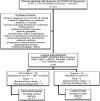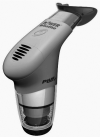Inspiratory Muscle Training While Hospitalized With Acute COVID-19 Respiratory Failure: A Randomized Controlled Trial
- PMID: 37389410
- PMCID: PMC10289076
- DOI: 10.1097/JAT.0000000000000217
Inspiratory Muscle Training While Hospitalized With Acute COVID-19 Respiratory Failure: A Randomized Controlled Trial
Abstract
Although inspiratory muscle training (IMT) has been used in outpatient settings for patients who recovered from COVID-19 respiratory failure, little data exist to support earlier implementation in acute care hospitals. This study aimed to assess the safety and feasibility of IMT during the acute disease phase of COVID-19.
Design setting and patients: Sixty patients presenting with COVID-19 to a single academic medical center were randomized to control or intervention groups using systematic randomization.
Measurements: Participants in the control group had their maximal inspiratory pressure (MIP) measured at enrollment and hospital discharge. They were also asked for their rating of perceived exertion on the Revised Borg Scale for Grading Severity of Dyspnea and were scored by researchers on the Activity Measure for Post-Acute Care (AM-PAC) 6-Clicks Mobility Scale and the Intensive Care Unit Mobility Scale (IMS). Control group patients otherwise received standard care. Participants in the intervention group, in addition to the measures described previously, received inspiratory threshold trainers with the goal of doing 2 sessions daily with a physical therapist for the duration of their inpatient hospitalization. In these sessions, the patient completed 3 sets of 10 breaths with the trainer. Initial resistance was set at 30% of their MIP, with resistance increasing 1 level for the subsequent session if the patients rated their during-activity rating of perceived exertion as less than 2. Changes in functional outcome measures, amount of supplemental oxygen, hospital length of stay (LOS), discharge location, adverse events, and mortality were assessed in group comparisons.
Results: Of 60 enrolled patients, 41 (n = 19 in intervention and n = 22 in control) were included in the final data set, which required completion of the study, initial and discharge data points collected, and survival of hospitalization. Final groups were statistically similar. A total of 161 sessions of IMT were completed among the 19 patients in the intervention group. Mortality totaled 2 in the control group and 3 in the intervention group and adverse events during intervention occurred in only 3 (1.8%) sessions, all of which were minor oxygen desaturations. Sessions were unable to be completed for all potential reasons 11% of possible times. Dropout rate in the intervention group was 3 (10%). Both intervention and control groups demonstrated improved MIP, decreased supplemental oxygen requirements, improved function on the AM-PAC, and slightly decreased function on the IMS. Length of stay was shorter in the intervention group, and discharge disposition was similar between groups.
Conclusions: With a low number of recorded adverse events, similar mortality between groups, and successful completion of 161 exercise sessions, IMT may be a feasible and safe intervention for some hospitalized patients with COVID-19.
© 2023 Academy of Acute Care Physical Therapy, APTA.
Figures


Similar articles
-
Therapeutic respiratory and functional rehabilitation protocol for intensive care unit patients affected by COVID-19: a structured summary of a study protocol for a randomised controlled trial.Trials. 2021 Apr 12;22(1):268. doi: 10.1186/s13063-021-05210-y. Trials. 2021. PMID: 33845878 Free PMC article.
-
Safety and Efficacy of Imatinib for Hospitalized Adults with COVID-19: A structured summary of a study protocol for a randomised controlled trial.Trials. 2020 Oct 28;21(1):897. doi: 10.1186/s13063-020-04819-9. Trials. 2020. PMID: 33115543 Free PMC article.
-
Folic acid supplementation and malaria susceptibility and severity among people taking antifolate antimalarial drugs in endemic areas.Cochrane Database Syst Rev. 2022 Feb 1;2(2022):CD014217. doi: 10.1002/14651858.CD014217. Cochrane Database Syst Rev. 2022. PMID: 36321557 Free PMC article.
-
Inspiratory muscle training, with or without concomitant pulmonary rehabilitation, for chronic obstructive pulmonary disease (COPD).Cochrane Database Syst Rev. 2023 Jan 6;1(1):CD013778. doi: 10.1002/14651858.CD013778.pub2. Cochrane Database Syst Rev. 2023. PMID: 36606682 Free PMC article. Review.
-
Early intervention (mobilization or active exercise) for critically ill adults in the intensive care unit.Cochrane Database Syst Rev. 2018 Mar 27;3(3):CD010754. doi: 10.1002/14651858.CD010754.pub2. Cochrane Database Syst Rev. 2018. PMID: 29582429 Free PMC article. Review.
References
Grants and funding
LinkOut - more resources
Full Text Sources
